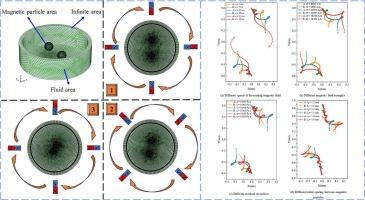操纵旋转磁场中的三维磁性粒子运动
IF 4.5
2区 工程技术
Q2 ENGINEERING, CHEMICAL
引用次数: 0
摘要
旋转磁场的应用可以减少细粒强磁性矿物在分选过程中的团聚效应。本研究建立了两个球形磁性颗粒在旋转磁场中团聚的三维有限元模型,并利用四极磁体构建了旋转磁场来验证模拟结果。结果表明,数值模拟结果能较准确地预测实验结果,磁粉在团聚过程中的运动轨迹为中心对称的螺旋曲线。利用旋转磁场以及增加旋转磁场速度、磁场强度和磁性粒子的初始间距,将增强磁性粒子摆脱团聚的趋势。本文章由计算机程序翻译,如有差异,请以英文原文为准。

Manipulating three-dimensional magnetic particles motion in a rotating magnetic field
The application of rotating magnetic field can reduce the effect of agglomeration of fine-grained strong magnetic minerals in the sorting process. In this study, a three-dimensional finite element model of two spherical magnetic particles agglomerated in a rotating magnetic field is established, and a rotating magnetic field is constructed using a quadrupole magnet to verify the simulation results. The results show that the numerical simulation results can predict the experimental results more accurately, and the trajectories of the magnetic particles in the agglomeration process are centrosymmetric spiral curves. The utilization of the rotating magnetic field as well as increasing the rotating magnetic field speed, magnetic field strength, and the initial spacing of the magnetic particles will enhance the tendency of the magnetic particles to get rid of the agglomeration.
求助全文
通过发布文献求助,成功后即可免费获取论文全文。
去求助
来源期刊

Powder Technology
工程技术-工程:化工
CiteScore
9.90
自引率
15.40%
发文量
1047
审稿时长
46 days
期刊介绍:
Powder Technology is an International Journal on the Science and Technology of Wet and Dry Particulate Systems. Powder Technology publishes papers on all aspects of the formation of particles and their characterisation and on the study of systems containing particulate solids. No limitation is imposed on the size of the particles, which may range from nanometre scale, as in pigments or aerosols, to that of mined or quarried materials. The following list of topics is not intended to be comprehensive, but rather to indicate typical subjects which fall within the scope of the journal's interests:
Formation and synthesis of particles by precipitation and other methods.
Modification of particles by agglomeration, coating, comminution and attrition.
Characterisation of the size, shape, surface area, pore structure and strength of particles and agglomerates (including the origins and effects of inter particle forces).
Packing, failure, flow and permeability of assemblies of particles.
Particle-particle interactions and suspension rheology.
Handling and processing operations such as slurry flow, fluidization, pneumatic conveying.
Interactions between particles and their environment, including delivery of particulate products to the body.
Applications of particle technology in production of pharmaceuticals, chemicals, foods, pigments, structural, and functional materials and in environmental and energy related matters.
For materials-oriented contributions we are looking for articles revealing the effect of particle/powder characteristics (size, morphology and composition, in that order) on material performance or functionality and, ideally, comparison to any industrial standard.
 求助内容:
求助内容: 应助结果提醒方式:
应助结果提醒方式:


